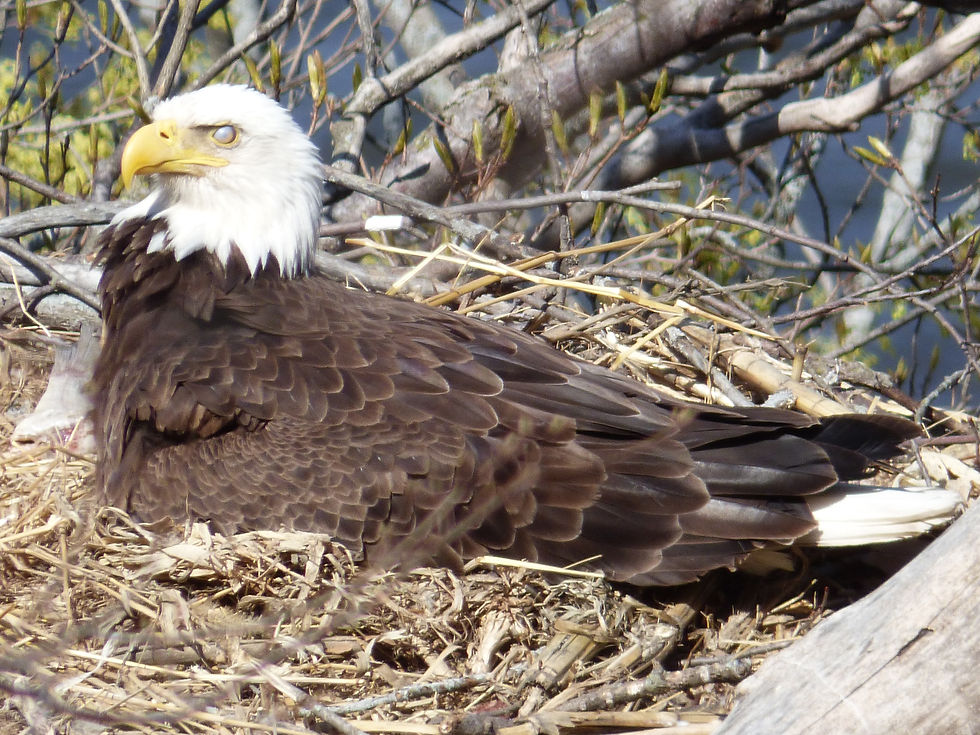Spring Flood- Could Have Been Worse
- Bruce Ause
- Mar 31, 2019
- 4 min read

Flooded Field
This was a most unusual winter with no snow until mid-January allowing for deep frost penetration. This was followed by record setting snowfall through February. To cap the season off, significant rains fell on March 13th and 14th creating flooded fields and roads.
We have lived in Wacouta for nearly 50 years and can never recall water flowing over the top of Wacouta Road north of the cemetery.

Fish Kill
Around March 17th, I started receiving reports of a significant fish kill at the Head of Lake Pepin adjacent to the Bay City Public Park. Hundreds of bluegills, crappies and shad were being observed floating on the surface of the open water.
These natural events are usually the result of oxygen depletion in the water. Heavy winter snow cover inhibits sunlight from penetrating the snow and ice preventing aquatic vegetation from producing oxygen through photosynthesis.

Scavenging Gulls
A college professor frequently mentioned that "nature abhors a vacuum." On Wednesday March 20th, I drove to Bay City to observe the extent of the fish kill and I was amazed at the number of birds taking advantage of the situation. Within a short distance of the dead fish, I counted no less than 50 bald eagles and a couple hundred ring-billed and herring gulls.

Conference Call
Among all the photos taken that day, I was surprised by one very unusual one. It consisted of a juvenile herring gull, a ring-billed gull and an American crow contemplating their next move.

Nesting Bald Eagle
In the midst of the heavy snows at the end of February, blizzard conditions of March 3rd and 4th and rains of March 13th and 14th, nesting bald eagles were attempting to incubate two or three eggs. With these challenges, is it any wonder nesting will be successful?
Looking closely at this adult eagle, you can observe a third eyelid known as a nictitating membrane. This membrane protects and moistens the surface of the eye. In our local area, we can expect the eaglets to start hatching around the first week of April.

Maple Sap
After nearly 50 years of making maple syrup every spring, I decided earlier this year to call it quits. This rite of passage into spring has been enjoyable and certainly memorable. Sharing the experience with others has been the most satisfying.
To soften the withdrawal symptoms of my decision, I still made one tap in our front yard soft maple. Sap collected was used for drinking, making tea and even a batch of baked beans. The recipe I used for the beans came from the late Howie Rapp, a good friend and respected "river rat."
Slow cook for 8 to 10 hours
2 cups navy beans
6 cups maple sap
1 small onion finely chopped
1 1/2 teas salt
2 slices of bacon
Drain liquid and add to it
1/4 cup molasses
2 tbs brown sugar
1 teas dry mustard
Mix liquid with the beans and heat to serve

Flueger Family Sugarbush
As I mentioned in the previous photo, exposing my ELC students to the mysteries and benefits of making maple syrup each spring gave me great satisfaction. Over the years, many families have been involved in keeping this activity alive. However, the family of the late John B. Flueger has kept this tradition going like none other.
With leadership from Dale and Scott Marty, this family activity has continued for at least 39 years! This past Saturday, I had the opportunity to visit their sugarbush in the bottomland adjacent to Hay Creek. According to Dale, after this many years of experience their techniques are very refined. This includes having an abundance of food to keep the helpers happy.

Skunk Cabbage Flower
Skunk Cabbage (Symplocarpus foetidas) is the first spring wildflower to bloom in our area. It is typically found near springs at the base of steep moist hillsides. It's flowers appear well before any foliage develops. Stepping on this foliage later in the season will result in the odor of skunk.
Skunk cabbage is a thermogenic plant meaning heat is given off from it's cellular respiration allowing it to melt it's way up through snow. I observed these flowers on March 26th.

Spring Flood
As I mentioned in the title of this post, we are having a significant flood this spring in the Red Wing area. However this could have been much different without some cooperation from the weather gods. Ever since the rainy weather of two weeks ago, we have experienced mild days followed by freezing nights to slow the melt and reduce the flood potential. Ironically, this weather has been a boon to the maple syrup production. The river level in Red Wing at the time this photo was taken was 14 feet. Predictions are for another 2 feet of rise before the crest.
"Come Participate And Help Celebrate Earth Day 2019"
Event # 1 Join the Friends of the Bluffs anytime between sunrise and sunset on Saturday April 20th for a hike and more on He Mni Can- Barn Bluff.
Event # 2 Attend the 2nd Annual "Wild And Scenic Film Festival" presented by the Red Wing Environmental Learning Center at 7:00 pm on April 20th at the Sheldon Theater. For details go to redwingelc.com




Comments